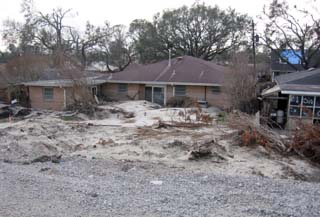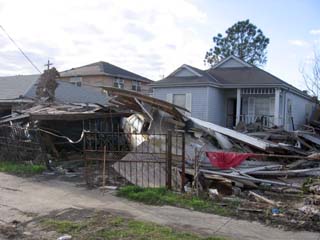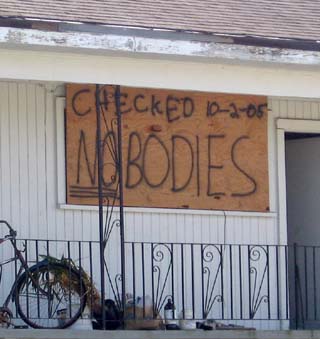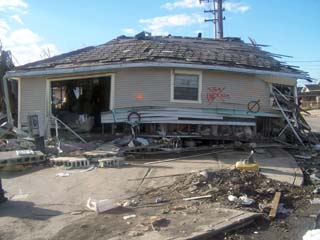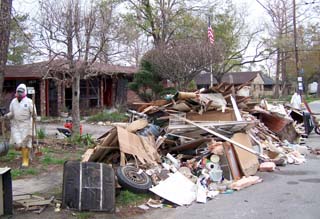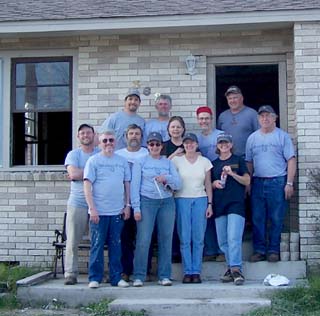
The high voltage snap of the sodium lights powering up overhead sent a shot of adrenaline through me, even though I was already awake. They glimmered dimly, then brightened, revealing rows of cots in formation across the large steel building. It was 6 a.m. I peered over the edge of my sleeping bag, half expecting a barrel-chested drill sergeant to explode into our quarters kicking a steel garbage can ahead of him. But it remained quiet, save the languid, purposeful sounds of groggy souls getting up and about. At 6:30 a.m., clapping coming from the tarped-off corner of the building signaled to stragglers that breakfast was served. The 10 of us who had ridden in a bus from Bergen Presbyterian Church sat together. After some yawns and moaning about the chorus of snoring in the night, our table was called and we ate in anxious, eager anticipation of what the day would demand of us. There were about 75 of us there. We had come from across the U.S. and Canada to help with Samaritan’s Purse disaster relief effort “mudding out” homes in New Orleans, Louisiana damaged by Katrina and subsequent flooding. After breakfast came housekeeping chores, then we were handed a job order with a name, address and description of work to be done: “Complete gut. Leave ceilings.” With it came a computer-generated map. Tools were loaded up into our bus and we left the “base camp” in Gretna and were soon inching our way, bumper to bumper, across the Mississippi toward New Orleans. Driving around the city proper, we gawked at the Superdome and envisioned the hordes of evacuees - wearied, bedraggled forms - that had marched down the very roads on which we traveled. We crossed the Industrial Canal, or as the locals say, went “over the hill” and we were ushered into another world - the vulnerable St. Bernard and ninth ward areas hardest hit, in some places having been submerged in 20 feet of water. The chatter on the bus became clipped and apprehensive as we took in the devastation. Deserted neighborhoods; hollowed out convenient marts; barren, eerily silent shopping malls; pale, gaping houses looking back at us as we passed, shocked, as it were, at finding themselves objects of such pity. Row upon row of abandoned homes bearing horizontal mud scars at various levels denoting where the water had temporarily settled before finally receding. More than one boat lay beached or overturned on the littered, muddied shoulder. Electrical wires and cables dangled from tilted poles like broken rigging hanging from masts of a ship that had been raked in battle by cannon ball and grape shot. The traffic, which was choked through the city, had ebbed dramatically. Still we approached the intersections slowly, with confused trepidation. Stop signs were often missing. One person who had survived the flood told us that people would grab hold of these signs as the water rose, only to float away with them as they pulled easily from the mucky, water-logged soil. We drove deeper in search of our quarry - a one story, brick home. We passed a vacated apartment building that had been graffitied with black spray paint across the clapboards: “No Bodies Found.” Every house had a large “X” spray painted across the front door, or on the brick facade or sometimes on the roof, which may have been the only portion of the home protruding above the flood waters. In the top quadrant of this “X” was the date inspected: “9/1,” to the left were the initials of the National Guard troop or rescue unit doing the inspection. The remaining quadrants were reserved for the number of live or dead bodies found. With relief, we noted most filled with zeros. But not all were so fortunate. Two doors down from a house we would later work on, a woman had lost her elderly husband. He had slipped off the roof into the murky waters. A large man with a heavy New Orleans drawl had stopped by to tell us his story. His mother had refused to leave. She was quite old and in failing health. She passed away before the waters receded. “I gave her what she wanted,” he said,” to die in her own home.” He had his boat parked on a trailer in the driveway and launched it as the waters came in. He helped rescue a 16-year-old girl and her baby. He admitted to some essential looting. Gasoline for his boat. Food which he would grab right off the shelves as he trolled his boat up and down the aisles of the open, abandoned grocery stores. He was perplexed by those who pillaged VCR’s or big screen televisions. “What would you do with them here?” he queried. We finally located the house - we guessed. Missing numbers and street signs made difficult work of a simple task. We filed off the bus into the lifeless, ghoulishly silent street - the only activity, an occasional work truck passing through. At the end of the road was a school, its parking lot lined with rows of unoccupied FEMA trailers. We learned from one of the few city workers we saw that they would be housing for the teachers. Presumably teachers would be among the first to return. Schools were only one of the institutions that would have to be up and running before evacuees could return to some sense of normalcy. It was a city where only 200,000 of the 456,000 residents had returned. Two-thirds of the surviving homes and businesses had no electricity, phone or gas. We were sobered by the enormity of the need. Our own problems had suddenly become absurdly trivial. Becky from Ohio and Tammie from South Carolina, two women who had come down on their own and had joined our group, were first to don the carbon-filtered masks, gloves, rubber boots and the hooded, zip-up protective Tyvek suits. Without hesitation they began attacking the moldy, mud-stained sheetrock walls with hammers and crowbars. On this, their second trip to the crippled city, they knew the drill and set the standard for the rest of us. The water had receded five months ago, but it left behind muddied floors and soggy drywall - a veritable nursery for mold and a haven to large, caramel-colored cock roaches, as well as the occasional Copperhead snake. “Take care what you reach into,” we were told. There was little chance of avoiding the stark reality of our grim task. “Pulling the little girls’ moldy pink dresses out of the closet, still on the hangers - that really got to me,” says Russ Kern, father of two girls, now grown. “Up until then, the neighborhood had not seemed real. It was more like a dream, a ghost town. This really is someone’s home. Now it’s all gone.” Stu Freeman, grandfather of five, had begun work inside the house, which had clearly been occupied by a family with young children. “I wasn’t handling it well,” he recalls. “I left to work in the back yard.” There he discovered a wooden, name plaque that must have been washed out of the home during the flooding. It read “Makala.” Then he found another with a boy’s name on it. That personalized the work for Stu. He returned inside to work. “You go down and see all this stuff, and it’s really rough,” said Richard Mayne, who at 63, was the oldest of our group. “You don’t know their pain because you’re not them. But these people, they lost their homes, their belongings, their jobs. If you dwelled on it too much, it would just bring you to tears.” Team member Bruce Partridge’s natural humor helped diffuse the heaviness. “I could never be a super hero,” he’d lament, struggling hopelessly to get into his extra large, Tyvek protective suit complete with hood and booties. “I’d be too dang slow getting into my suit.” Some of our team would occasionally search out neighbors, evacuees who had returned and were working on their homes, often in isolation. Words of encouragement were given, prays offered, tears shed. Donated quilts were given to them, and stuffed animals or soccer balls for their kids, all provided by Samaritan’s Purse. At the end of one day, Sandy Player noted sadly, “I didn’t see any children today. No animals.” But characteristically her despair would pendulate to hope, “They are gonna bring it back,” she’d say. “They’ll bring it back.” After a full day of gutting, we peeled off our sweaty, soiled Tyvek suits, added them to the growing pile of debris by the curb and headed through the slow city traffic, back to our temporary home. Between 5 and 6 p.m. we took showers in a trailer with seven private stalls. It was an unexpected luxury for many of us who, when we first volunteered, thought we might be staying in tents and taking sponge baths. Meals were prepared by master chef Francois in a food service truck out in the parking lot. After dinner was the time for volunteers to talk about their progress and share stories. A crew from Ohio had completed their house in one day. The rest of us suddenly felt inadequate. We still had another day’s work left on our house and it had been started before we arrived. We wondered what we were doing wrong? There was little free time. Lights would go out at 9:30, quietly enforcing the disciplined regimen that helped us focus on our mission. Gutting out homes in hot, Tyvek suits was grueling work and many were already in their bunks in grateful anticipation of the fast approaching “lights out.” The night owls stayed up and read or journaled by flashlight. Others talked quietly outside or wandered the facility grounds with a cell phone to their ear relaying the day’s experiences to loved ones. By the third day we were off to the next house in a different area north of the city. The police detective whose parent’s home we were to work on was waiting for us. Samaritan’s Purse gave precedence to the elderly, those without flood insurance and members of the police force - a necessary though often neglected segment of the affected population. After a few quick instructions we were off and running. Ed Martin, an engineer, who was the youngest, and at 6' 3", the tallest among us, began in the kitchen. He noted the signs of a hasty departure - dishes were still in the sink. It was too personal, he later recalled, somehow he felt an intruder. He moved to a different, less personal space to begin work. This area had much more activity. Houses were being gutted, some rebuilt, and city workers patrolled the streets separating and cleaning up piles of debris. On breaks we had visits from neighbors. A graying, New Orleans native was rebuilding his house two doors down. He had a FEMA trailer in his yard. Power and sewer were hooked up and it was ready for use, but with no one available to give the final inspection, it remained locked. He showed us a picture of his wife and young daughter who he hoped could soon join him to live in the trailer while they rebuilt their home and their lives. Everyone we saw had a unique story to tell. A common request was that we take these stories back with us. “Tell them what you see,” they pleaded. They wanted their country to hear it from people who had been there, who had smelled the copious mold, who had muddied their boots with Louisiana clay and soiled their clothing with the city’s distress. The next day, the detective stopped by. This was the house he grew up in - he and his two brothers. Up until the flood, it had remained the center of activity for the family. We showed him the pile of personals we saved: Marine uniforms, miscellaneous valuables, a few pictures. He recognized the pictures. “Nieces and nephews,” he said. Throughout the week we found ourselves asking: Why this disaster? Why this hardship on these people? But here disaster had turned to opportunity; opportunity to touch someone we would have never known, to give what we didn’t know we had to give. The week had been short, the work accomplished too little, dwarfed by the need. But team leader John Gay was quick to remind us: “Sure, we only did two houses, just a spit in the ocean. But now there are two less houses in New Orleans that need to be done.” Our last house was completed early Friday afternoon. We took one last look at the flag Charlie had positioned atop the fledgling, storm ravaged flag pole in the front yard. It licked the warm breeze and hovered in hope above the mountain of debris. Note: For information on the relief effort see www.samaritanspurse.org. April 9, 2006 |
